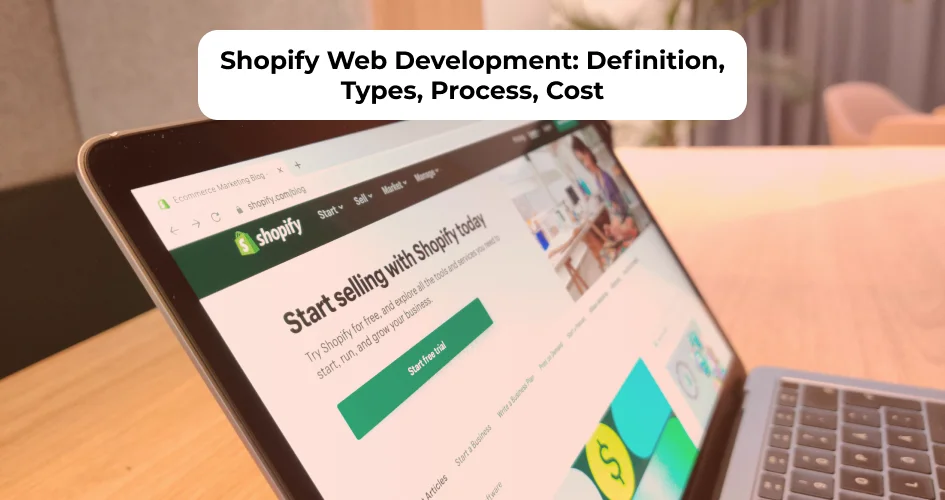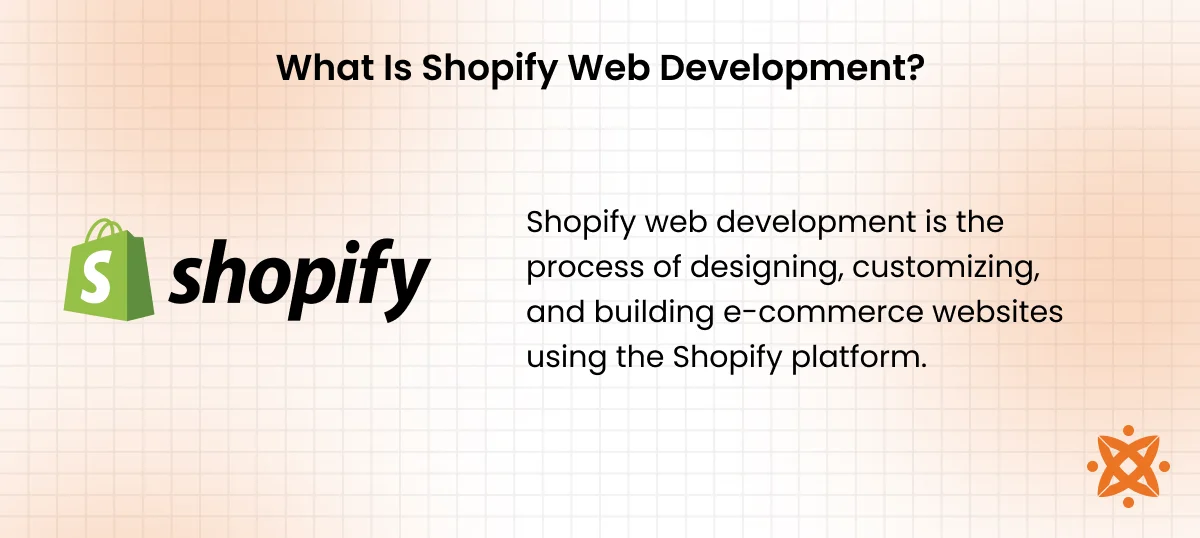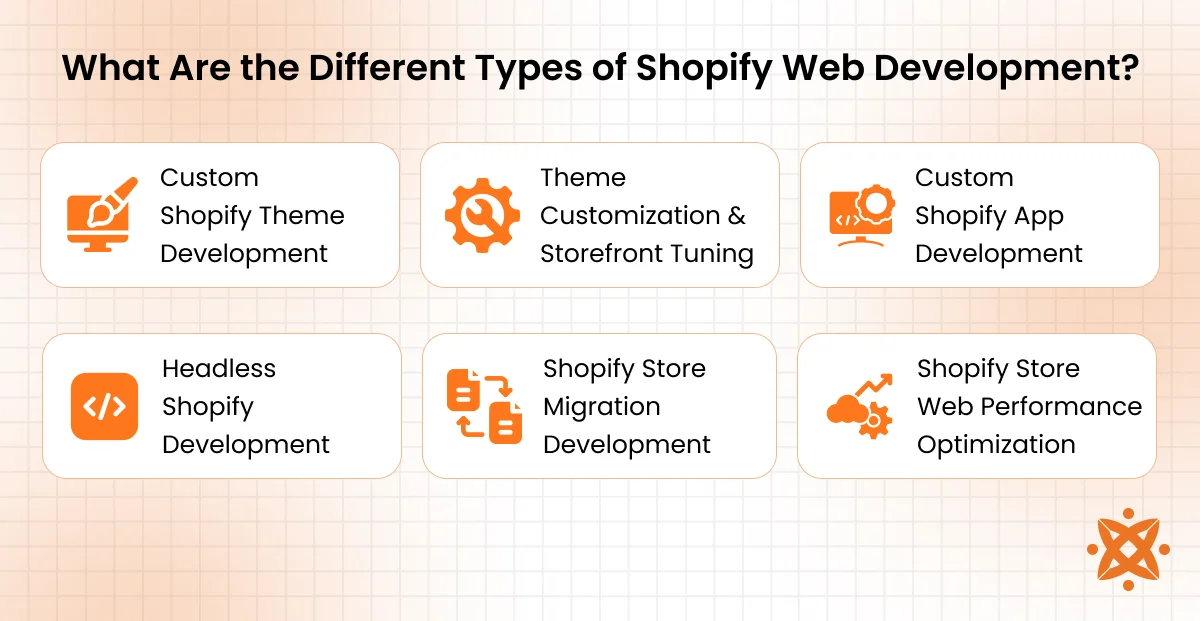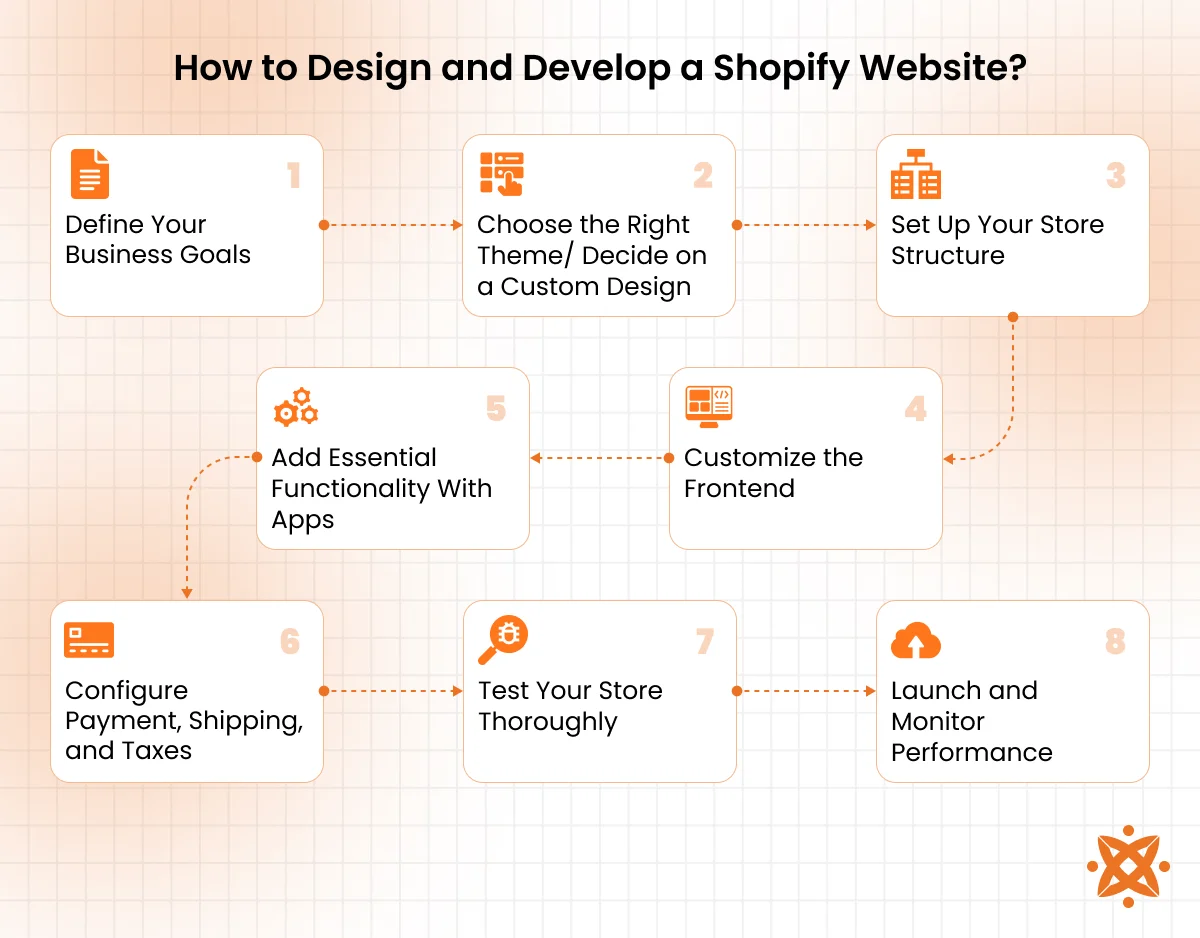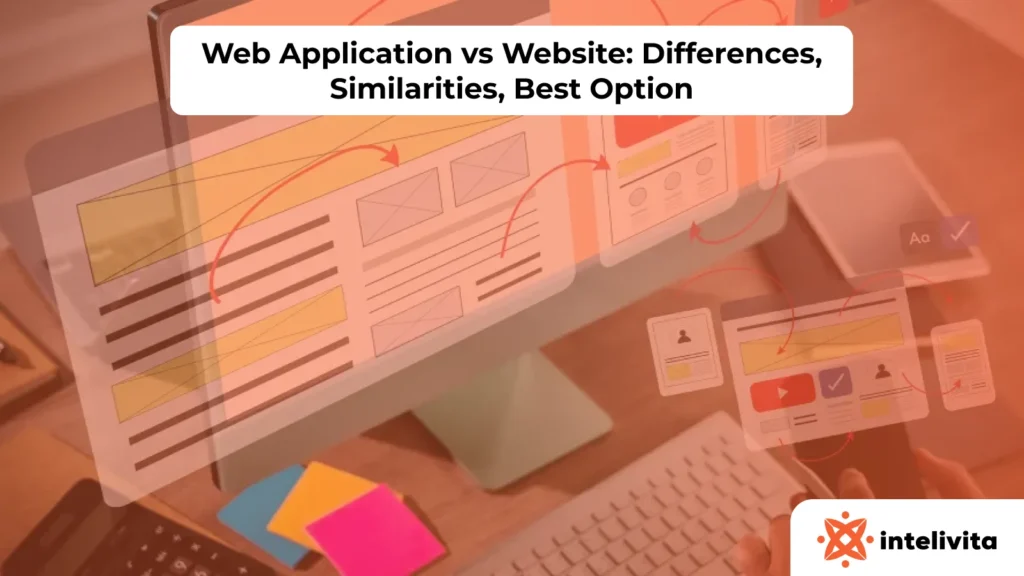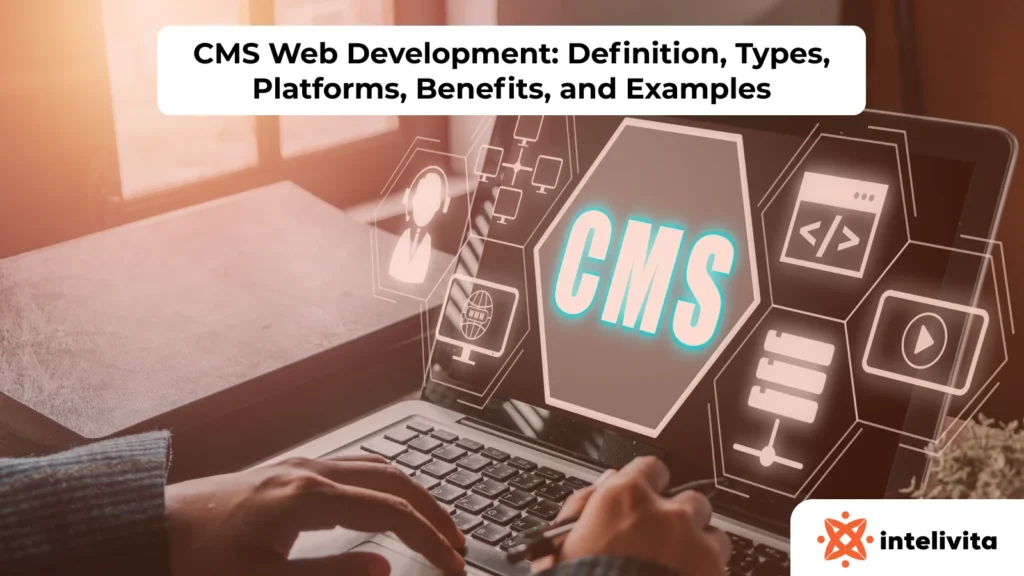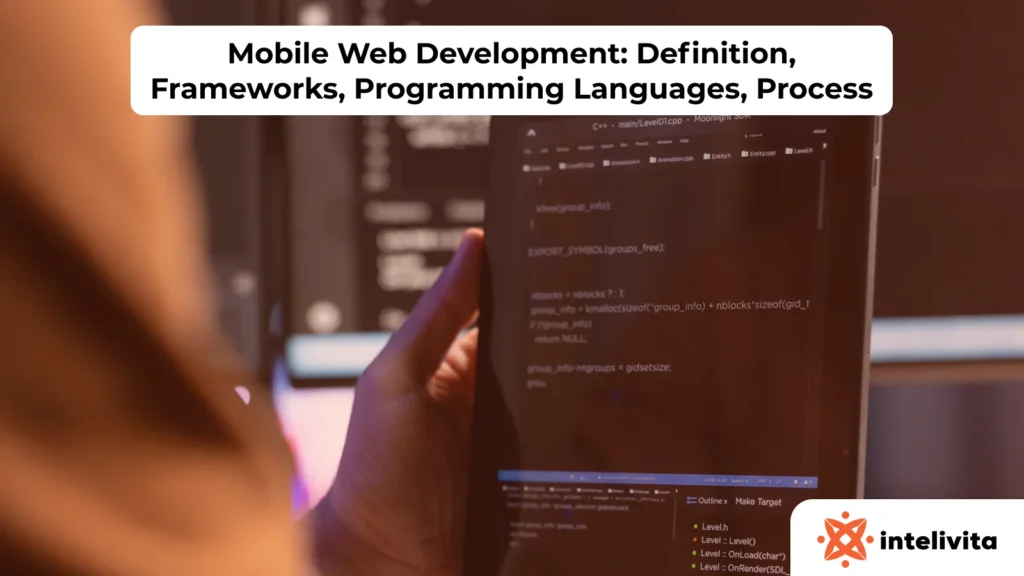Shopify web development involves creating and customizing an online storefront using the Shopify eCommerce platform, including building themes, apps, and integrations through tools like Liquid, Shopify CLI, and Shopify App Bridge. It helps brands launch scalable stores with features like cart functionality, payment gateway integration, and responsive product pages.
There are different types of Shopify web development, such as custom Shopify theme development, Shopify app development, headless Shopify integration, store migration, and storefront optimization. Each focuses on specific parts of enhancing or extending your Shopify Store experience using custom code and third-party apps.
To build a Shopify website, you select a Shopify Theme, customize it using Liquid and HTML/CSS, organize collections pages and products, install needed third-party apps, and configure shipping, tax, and payment gateway settings. Once tested for performance and mobile responsiveness, the site is launched through the Shopify Admin API and backend dashboard.
The average app development cost for a Shopify website ranges from $2,000 to $30,000+, depending on the store’s complexity, whether you use a prebuilt theme or build a custom one, and whether advanced features like Shopify App integrations or custom scripts are needed.
According to BuiltWith 2024, Shopify powers over 4.8 million websites globally, giving business owners a reliable, secure, and scalable platform to sell products online
When choosing a Shopify web development company like Intelivita, look for verified Shopify Experts, proven experience with Liquid and Shopify App Development, and a strong portfolio of responsive storefronts.
What Is Shopify Web Development?
Shopify web development is the process of designing, customizing, and building e-commerce websites using the Shopify platform. It involves working with themes, templates, apps, and code (mainly Liquid, HTML, CSS, and JavaScript) to create a store that looks good, performs well, and supports your business goals.
Shopify gives business owners a reliable, secure, and scalable platform to sell products online. Whether you’re a startup launching your first product or an established brand migrating from another system, Shopify helps you build a high-converting online store without dealing with the complexities of custom backend development.
Shopify began in 2006 as a simple solution for selling snowboards online. Over the years, it has evolved into a complete eCommerce ecosystem with developer tools, app integrations, headless commerce support, and Shopify Plus for enterprise-level solutions. Today, Shopify web development isn’t just about themes; it’s about creating fast, mobile-optimized, and conversion-driven shopping experiences tailored to any business size.
What Are the Different Types of Shopify Web Development?
The different types of Shopify web development include custom theme development, custom app development, headless Shopify development, and store setup and customization. Each type serves a specific purpose, from designing the storefront to building custom functionalities and integrating with third-party systems.
The different types of Shopify web development are as follows:
Custom Shopify Theme Development
Custom Shopify theme development is the process of building a fully unique store layout from the ground up using Shopify’s templating system. It involves writing code with Liquid, HTML, CSS, and JavaScript to create a storefront that reflects your brand’s identity, functions intuitively, and offers full design flexibility.
A custom Shopify theme development approach is ideal if you want a Shopify site that doesn’t rely on pre-built themes and requires completely original layouts or features. This type of development is chosen by growing brands or businesses that want complete control over the customer journey, mobile experience, and page structure.
Developers use tools like Shopify CLI, Git, and Theme Kit to build and deploy the theme efficiently.
Theme Customization and Storefront Tuning
Theme customization and storefront tuning involve modifying an existing Shopify theme to better match your brand’s visual identity and improve performance. It’s perfect when you don’t need a full custom build but still want changes in layout, typography, sections, or product pages.
The theme customization and storefront tuning process uses Liquid, CSS, and basic JavaScript, along with Shopify’s theme editor for quick design changes. It’s faster and more affordable than custom development, making it a great choice for new stores or small businesses.
Custom Shopify App Development
Custom Shopify app development allows you to build tailored functionalities that aren’t available through built-in features or existing apps. These apps automate tasks, connect third-party services, or add completely new features to your store.
Apps are developed using frameworks like Node.js, React, and Ruby on Rails, and they communicate with your store via Shopify’s Admin API or Storefront API. You build public apps for the Shopify App Store or private apps for internal use.
Headless Shopify Development
Headless Shopify development is when you decouple the frontend and backend of your store, using Shopify only for backend commerce functions like product management and checkout. The frontend is built with modern JavaScript frameworks for more freedom and performance.
Headless Shopify development setup uses technologies like Next.js, Gatsby, or Vue.js on the frontend, while connecting via GraphQL or Shopify Storefront API. It’s ideal for large-scale businesses needing highly customized UX, speed, and flexibility.
Shopify Store Migration Development
Shopify store migration development involves transferring all key data, products, collections, orders, and customers from another platform (like WooCommerce or Magento) into Shopify. It ensures the switch is smooth, secure, and doesn’t lose SEO value or historical records.
Migration tools like Shopify’s native import, Matrixify, or custom scripts are used, depending on store size and complexity. Developers also handle theme setup and app replacements to replicate or improve the original store experience.
Shopify Store Web Performance Optimization
Shopify store web performance optimization focuses on improving your site’s speed, responsiveness, and overall performance. This directly affects user experience, conversion rates, and SEO rankings.
Key tasks of Shopify store web performance optimization include optimizing images, reducing third-party scripts, minimizing Liquid and JavaScript code, and using performance auditing tools like Lighthouse and Shopify Analyzer. A faster site means happier users and better business results.
How to Design and Develop a Shopify Website?
To design and develop a Shopify website, you start by choosing a theme or building a custom one using Liquid, then structure pages, products, and navigation based on your store goals. You’ll also configure settings, integrate payment gateways, install necessary apps, and test everything before going live to ensure a smooth shopping experience.
The steps to design and develop a Shopify website involve the following:
Step 1: Define Your Business Goals
The first step in designing and developing a Shopify website is to clearly define your business goals. You should identify what products or services you want to sell, who your target audience is, and what features your store must have. This helps shape the design, layout, and functionality needed for your Shopify site. Without clear goals, development decisions may lack focus or fail to support your objectives.
Step 2: Choose the Right Shopify Theme or Decide on a Custom Design
You can either select a pre-built theme from the Shopify Theme Store or go for a fully custom design based on your branding. A good theme should be responsive, lightweight, and optimized for mobile users. Custom design, on the other hand, gives you more control over layout and user experience. Your decision should be based on budget, time, and how unique your storefront needs to be.
Step 3: Set Up Your Store Structure
Organize your product categories, navigation menus, and content pages in a way that makes browsing easy. Shopify allows you to create collections, subpages, and menus directly from the admin panel. Proper store architecture improves user experience and SEO performance. You should also configure basic settings like currency, language, and shipping zones at this stage.
Step 4: Customize the Frontend
Use Shopify’s Liquid language, along with HTML, CSS, and JavaScript, to adjust the look and feel of your store. This includes editing page layouts, fonts, colors, and product displays. Frontend customization allows you to align the visuals with your brand identity. For minor changes, you use the Shopify Theme Editor; for deeper edits, access the theme’s code directly.
Step 5: Add Essential Functionality With Apps
Install apps from the Shopify App Store to extend the core features of your site. These help with email marketing, upselling, SEO, reviews, subscriptions, and more. Be selective, too many apps can slow down your store. Choose apps that add measurable value to your business operations.
Step 6: Configure Payment, Shipping, and Taxes
Go to your Shopify settings and set up payment gateways like Shopify Payments, PayPal, or Stripe. Then define your shipping rates, delivery zones, and tax rules according to your business region. Accurate setup here ensures smooth transactions and fewer abandoned carts. Test all configurations to confirm everything works as expected.
Step 7: Test Your Store Thoroughly
Before launch, test all parts of your store, like product pages, checkout flow, navigation, mobile responsiveness, and loading speeds. Use tools like Google Lighthouse or Shopify’s performance dashboard. You want to catch and fix any technical issues before customers do. A seamless shopping experience builds trust and encourages purchases.
Step 8: Launch and Monitor Performance
Once everything is in place, remove your store password and go live. After launch, monitor traffic, sales, bounce rates, and conversion rates using tools like Shopify Analytics and Google Analytics. Use this data to identify what’s working and what needs improvement. Continuous optimization is key to long-term success.
How to Choose a Shopify Web Development Company?
To choose a Shopify web development company, look for one with a strong portfolio, verified Shopify expertise, and experience in building stores similar to yours. You should also check client reviews, discuss timelines and pricing clearly, and ensure they understand your business goals before you sign a contract.
Tips to choose a Shopify web development company include the following:
- Look for Shopify-certified expertise: Choose a company that has verified Shopify Partners or Shopify Experts to ensure your project meets platform standards.
- Review their past work: Browse their portfolio to see examples of responsive Shopify store design, especially in industries similar to yours.
- Ask about custom app capabilities: If your store needs added features, confirm they offer Shopify app development services and have built private or public apps before.
- Prioritize communication and support: A good agency should be responsive, transparent, and willing to walk you through every phase of the project.
- Consider scalability: Make sure they can handle upgrades, performance tuning, and long-term support as your business grows.
Choosing the right web development company saves you time, money, and frustration. That’s why you should consider Intelivita for your Shopify web development needs in the USA, Canada, or nearby locations. They offer tailored solutions, quick turnaround times, and a team of expert developers ready to help you hire Shopify expert developers and scale your eCommerce business smoothly.
How Much Does It Cost to Develop a Shopify Website?
It costs an average of $2,000 to $30,000+ to develop a Shopify website, depending on the complexity of the store and whether you’re using a pre-made theme or opting for full custom development.
The price varies based on the type of design (basic or custom), the number of pages and products, custom feature development, integration of third-party apps, and whether you require Shopify app development services.
Hiring an agency or Shopify expert developer in the USA or Canada generally increases the web development cost due to higher hourly rates, while offshore developers offer more affordable options with varied expertise.
Ongoing costs like domain registration, Shopify’s monthly plan (ranging from $39 to $399/month), paid apps, and maintenance also contribute to your total budget. A small business using a prebuilt theme might spend under $5,000, while a larger brand needing a responsive Shopify store design, custom UX, and app integration could spend $20,000 or more.
What Are the Best Practices for Shopify Website Development?
The best practices for Shopify website development are using a mobile-first, responsive design, optimizing images and code for fast load times, and keeping navigation intuitive and user-friendly. You should also regularly update your apps and theme, follow SEO best practices, and use analytics tools to track performance and improve conversions.
The best practices for Shopify website development include the following:
- Start with a clear goal: Before development begins, outline your store’s purpose, product categories, and customer journey. This helps shape both design and functionality.
- Use mobile-first responsive design: Since most shoppers use smartphones, ensure your Shopify store design is mobile-optimized across all devices.
- Stick to clean and simple navigation: Easy-to-use menus and category filters help users find what they need faster, reducing bounce rates and improving conversions.
- Optimize page speed: Compress images, limit third-party apps, and use Shopify’s performance tools to keep your site fast and smooth.
- Focus on SEO basics: Customize your meta titles, URLs, image alt tags, and product descriptions to help your store rank in search results.
- Integrate essential apps only: Don’t overload your site with apps; only use those that improve marketing, user experience, or backend efficiency.
- Test before going live: Always preview your site on different browsers and devices, and test the full buying process to avoid issues at launch.
- Use professional product photography: High-quality, consistent images boost credibility and help customers make purchase decisions.
- Regularly update and maintain: Shopify themes and apps evolve, so stay up to date to fix bugs, add features, and improve security.
What Are the Common Shopify Web Development Mistakes to Avoid?
The most common Shopify web development mistakes to avoid are using too many third-party apps, neglecting mobile responsiveness, and overlooking SEO settings like meta titles and structured data. Any of these hurt your user experience and sales.
The common Shopify web development mistakes to avoid include the following:
- Overusing third-party apps: Adding too many apps slows down your store and creates code conflicts that affect performance.
- Ignoring mobile responsiveness: Most shoppers browse on phones, so a poor mobile layout can lead to lost conversions.
- Skipping SEO setup: Not configuring meta titles, descriptions, or image alt texts hurts your visibility on search engines.
- Using large or unoptimized images: These increase load times and frustrate users, especially on mobile connections.
- Weak CTAs or unclear navigation: If users can’t find what they’re looking for or don’t know what to do next, they’ll leave your store.
- Not testing or auditing regularly: Without frequent testing, you miss bugs, slow speeds, or broken checkout flows that damage sales.
What Are the Trends in Shopify Website Development?
The latest trends in Shopify website development include headless commerce using Hydrogen, building Progressive Web Apps (PWAs), integrating AI-driven personalization, and chat support. There’s also a strong shift toward sustainable eCommerce features, faster checkout experiences to meet unique store needs.
The following are the trends in Shopify website development:
- Headless commerce adoption: More brands are using headless Shopify setups with frameworks like Next.js and React for faster, more flexible frontends.
- AI-powered personalization: AI tools now help create dynamic product recommendations, personalized content, and better customer journeys.
- Augmented Reality (AR) product previews: Shopify now supports AR, letting customers virtually try or view products before buying.
- Progressive Web App (PWA) integration: PWAs improve mobile performance, allowing faster loading and offline capabilities in Shopify stores.
- Subscription and membership features: More stores are offering recurring revenue models using Shopify subscription apps and custom integrations.
- Sustainability and eco-branding: Consumers are favoring brands that highlight ethical practices and environmentally friendly shipping during the buying journey.

